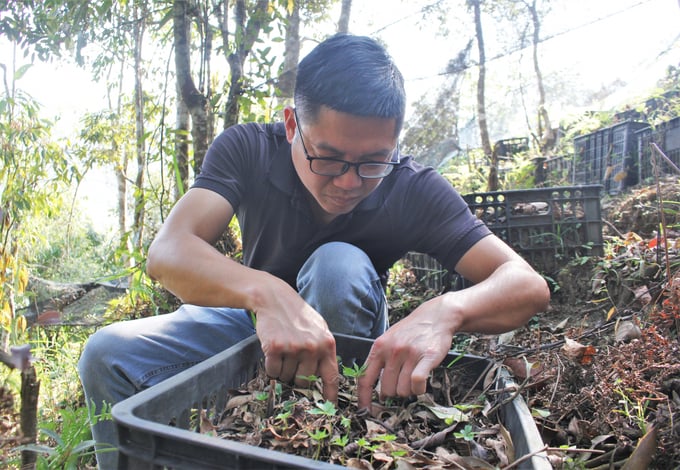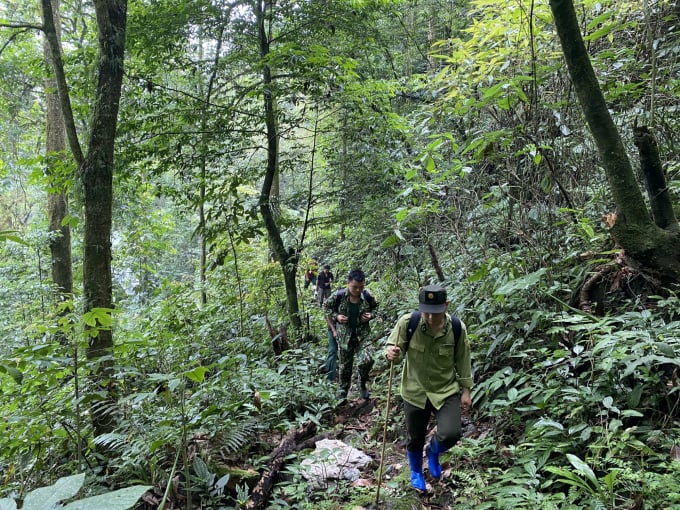November 25, 2025 | 18:12 GMT +7
November 25, 2025 | 18:12 GMT +7
Hotline: 0913.378.918
November 25, 2025 | 18:12 GMT +7
Hotline: 0913.378.918
The National Agricultural Extension Center (NAEC) recently organized the Agriculture Extension @ Agriculture Forum in Lai Chau with the theme " Solutions to develop medicinal herbs along the value chain associated with ecotourism".

Ethnic minorities in Xin Chai village, Giang Ma commune (Tam Duong district, Lai Chau) participate in growing ginseng to improve the family economy. Photo: T.L.
Statistics of scientists show that there are more than 5,117 species of vascular plants that have been discovered in forest ecosystems in Vietnam alone, which are used as medicine and health enhancement food.
Most of the precious, rare and valuable medicinal plants are found in natural forest ecosystems, such as Lai Chau Ginseng, Vu Diep Ginseng, wild notoginseng, Lilium brownii, Himalayan yew, yellow vine, leatherleaf mahonia, wintergreen barberry, Nervilia fordii, and bristly anoectochilus.
Precious and valuable herbal species usually live under the forest canopy, especially under the canopy of the primeval forest. Vietnam currently has more than 10.1 million ha of natural forests. This advantage can be considered great potential, feasible to develop herbs under the forest canopy.
However, not every forest canopy is suitable to grow medicinal herbs, not to mention the rare ones. The problem of developing medicinal herbs under the canopy of natural forests, particularly primary and secondary forests, still has certain limitations due to regulatory mechanisms and policies.
Only pilot leasing forest environment services to grow Ngoc Linh ginseng in Quang Nam has been carried out at present, but it already sparks controversies, with some saying that the State should only lease forest environment to develop ecotourism services while not affecting the forest and forest land. Some other views believe that the lease of forest environment must be allowed to affect forest land to grow medicinal herbs.

Le Quoc Thanh, Director of the National Center for Agricultural Extension, spoke at the Agriculture Extension @ Agriculture Forum. Photo: T.L.
Most recently on June 1, 2023, the Prime Minister issued Decision No. 611 approving the Program "Developing Vietnamese ginseng until 2030, with orientation to 2045". The Ministry of Agriculture and Rural Development is also drafting an implementation plan. The decision being approved would be an opportunity not only for Vietnamese-branded ginseng but also for other medicinal herbs grown under the forest canopy.
Lai Chau's forests have a large area and high biodiversity, of which rich and medium forests account for approximately 13%, forests with absolute altitudes from 900 m to 1,400 m approximately 29%, forests with absolute altitudes from 1,400 m to over 3,100 m approximately 32%. In addition, the main soil types in Lai Chau’s forests include the red-yellow soil group and the red-yellow humus soil group with many characteristics suitable for the development of precious, high value medicinal herbs.

Many units and businesses have invested in developing Lai Chau ginseng. Photo: Trung Quan.
Seeing the big potential, Lai Chau has actively attracted businesses and encouraged cooperatives, communities, households and individuals to participate in economic development under the forest canopy. The province has approved a scheme to develop a number of medicinal herbs in the 2020 - 2025 period, with a vision for 2030. The scheme identifies the focus on growing medicinal plants in the direction of concentrated commodity production, linking production and consumption.
“Particularly for Lai Chau ginseng, the province has determined that this is an endemic plant with great potential and strength, perfect for development towards concentrated commodity production. The provincial People's Committee has directed the specialized agency to research, review and build a map of the suitable area for growing Lai Chau ginseng in the province.
“The research unit will also advise the provincial People's Committee to propose the contents of Lai Chau’s participation in the Vietnamese Ginseng Development Program and build a plan to develop Lai Chau ginseng with a scale of 3,000 ha by 2030 and 7,000 ha by 2045, bringing the total area of Lai Chau ginseng in the province to 10,000 ha,” said Nguyen Trong Lich, Deputy Director of Lai Chau Department of Agriculture and Rural Development.

The people of Lai Chau introduce to tourists locally-grown ginseng products and promote them on social networks. Photo: T.L.
having high mountain topography, unique natural, cultural and social conditions, along with a system of historical and cultural relics and scenic spots, Lai Chau is identified as one of six important regional and national tourist attractions.
Hoang Quoc Viet, PU Lai Chau Tourism and Trade Co., Ltd, said, “The current tourism trend is small group tourism. They tend to select activities of resort, health care, and agriculture - herb experience, pursue journeys that are full of experience and close to unspoiled nature, and enjoy the original culture and cuisine. Lai Chau can give tourists these experiences”.

A large proportion of primary forest and high biodiversity are very favorable conditions for Lai Chau to develop medicinal herb growing associated with tourism. Photo: TL.
A number of rural tourism models have been put into operation in Lai Chau, collaborating with local people to create new values and experiences for tourists.
Accordingly, tourists can experience a day with the Mong people to pick tsaoko cardamom, or with the Dao people to make seaweed and take care of rare herb gardens, work on the field with the Thai people in the morning, savor rice balls and the clear stream water by the field at noon, then come home and have a cozy meal by the fire, enjoy the singing, the Khen panpipe, and the indigenous dances when night falls. Adventurous tourists can climb the peaks of Lai Chau and go through the bamboo forest to pick bamboo shoots.
“Tourism in Lai Chau ginseng area aims toward high-paying customers. They are ready to spend money on their own and their family's health, and only require emotional, quality experiences. Therefore, health tourism and agriculture - herb experience tourism contribute to diversifying products and services, bringing rich experiences to customers while creating development opportunities for businesses and ethnic minorities when joining this tourism service supply chain,” Hoang Quoc Viet said.
Translated by Samuel Pham
/2025/11/24/3536-2-112800_176.jpg)
(VAN) Dong Nai now has tens of thousands of hectares of forests certified for sustainable management, and this area will continue to be expanded in the coming period.

(VAN) Vinh Ha hamlet (Dai Xuyen commune, Hanoi) is shifting away from small-scale farming as households adopt bioscurity into their breeder chicken models.

(VAN) Heavy rains make aquatic species more vulnerable to disease. Proactive water management and high-tech systems help farmers prevent outbreaks and protect yields.

(VAN) Greenhouses are shifting production mindsets in Binh Lu commune, enabling farmers to ‘weather the sun and rain’ and secure stable vegetable harvests throughout the year.

(VAN) Green transition is crucial for the Mekong Delta amid climate change and stricter standards, offering a path toward sustainability.

(VAN) Dong Thap promotes agricultural restructuring, forms large specialized farming zones, raises the value of agricultural products and develops toward ecological and high-tech directions.
/2025/11/22/4018-4-213342_747.jpg)
(VAN) The Mekong Delta Agricultural Experts Club has attracted 143 experts and researchers to participate in providing consultancy and contributing initiatives to the development of one million hectares of high-quality rice.